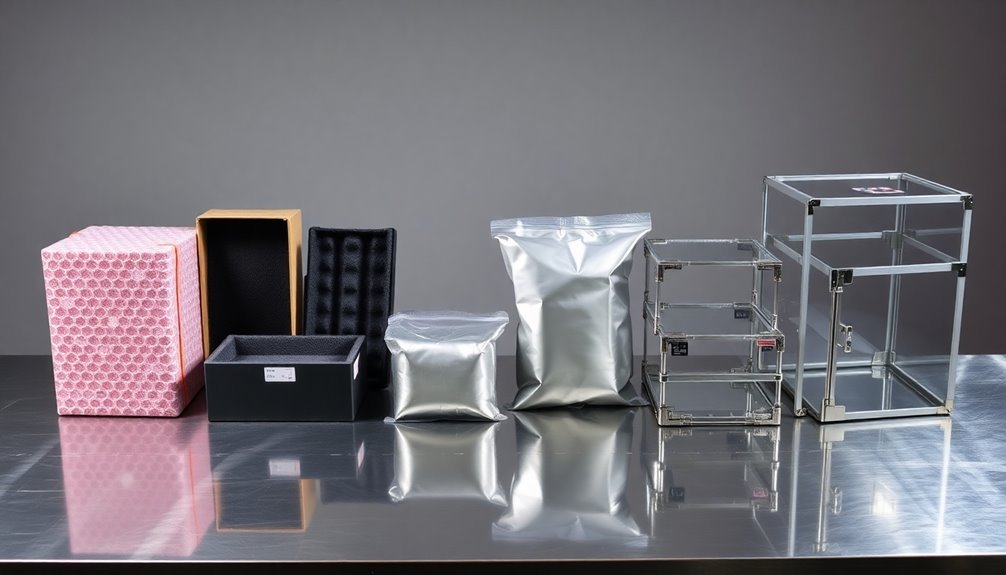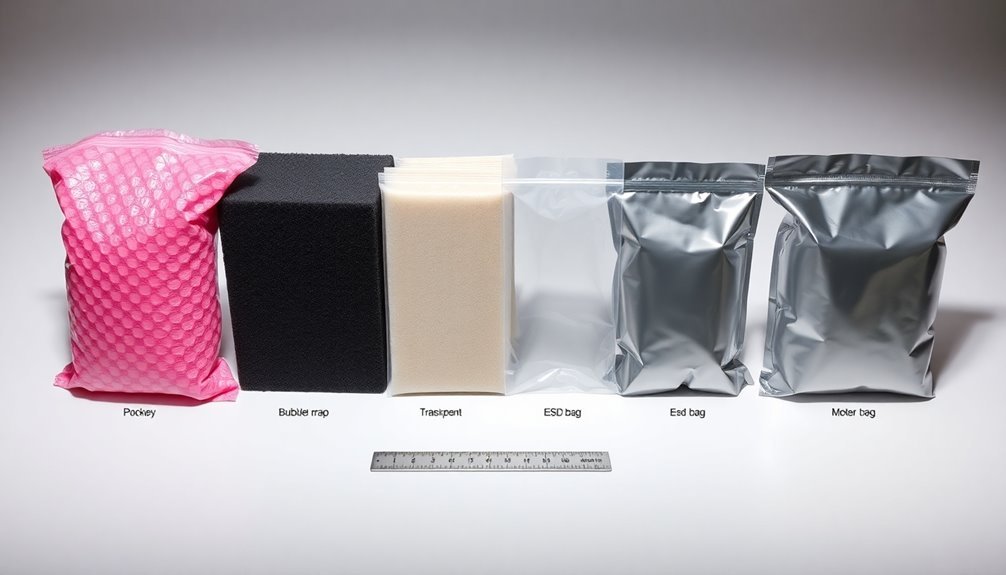While you'll face higher upfront costs of around $7 per reusable ESD tote, the long-term savings make it worthwhile. You can expect a 64% reduction in manufacturing energy costs and elimination of thousands of single-use plastics. Most companies achieve ROI within one year, with some automotive applications seeing returns in just six weeks. Your best options include ESD clamshells, which reduce storage space by 75%, and anti-static foam solutions that offer multiple uses. Smart material choices like Corstat and Corriplast maximize durability while minimizing replacement needs. The true value of reusable ESD packaging extends far beyond initial price tags.
Understanding Reusable ESD Packaging Costs

Industry's shift toward reusable ESD packaging reflects a compelling cost equation that extends far beyond initial investments. While you'll find the upfront costs higher – with reusable totes running up to $7 each – the long-term financial benefits quickly outweigh these initial expenses.
You're looking at considerable savings in manufacturing energy, which is 64% lower compared to single-use alternatives. Current market data shows that sustainable solutions can be more cost-effective than fossil fuel-based options. One customer's commitment to reusable packaging can prevent 48,000 plastic bags from entering landfills over five years.
When you calculate the ROI, you'll discover that most reusable packaging systems pay for themselves within a year. In automotive applications with frequent transit cycles, you can achieve ROI in as little as six weeks.
Your investment in returnable packaging can cover years of usage, eliminating the need for repeated purchases of disposable options.
You'll need to evaluate your transit cycle carefully to maximize your returns. The more cycles you complete, the better your cost efficiency becomes.
Long-Term Savings Through Material Selection
Three key factors drive substantial long-term savings when selecting reusable anti-static packaging materials: durability, adaptability, and space efficiency.
You'll find significant cost advantages with reusable ESD clamshells, which reduce storage space needs by up to 75% while offering exceptional durability for multiple uses. Their recyclable composition and long lifespan make them more cost-effective than single-use alternatives. Pink poly bags provide essential moisture barriers that help extend component life and reduce replacement costs. Choosing static dissipative bags at $15.54 per 200 units offers an economical entry point for basic protection needs.
When you opt for custom-sized solutions, you can increase box densities by 18% and cut material usage by 30%, directly impacting your bottom line.
While pink anti-static bags offer flexibility through their adaptability and ability to be cut to size, you'll achieve greater long-term value with reusable options like anti-static foams and ESD clamshells. These materials help you minimize waste and reduce replacement frequency.
Materials like Evolon provide an additional advantage through their compact, threadless design, which protects sensitive components while maximizing space efficiency.
Durability Impact on Cost Efficiency

You'll find that investing in durable anti-static packaging materials, particularly reusable foams and specialized solutions, delivers considerable long-term cost savings despite higher initial expenses.
The material's lifespan directly impacts your return on investment, with high-quality ESD-protective foams lasting through multiple shipping cycles compared to single-use alternatives. Modern static control packaging significantly reduces product returns and damage-related expenses.
Your selection of wear-resistant packaging, such as Corstat and Corriplast materials, can notably reduce replacement frequency and overall operational costs while maintaining consistent static protection. Conductive foams offer excellent reusability while providing reliable protection against static charges in electronics shipping.
Long-Term Investment Benefits
Through careful analysis of long-term investments in reusable anti-static packaging, companies can achieve substantial cost savings while maintaining ideal product protection.
You'll find that the initial investment pays off through reduced replacement needs, minimized material waste, and potential bulk pricing advantages when establishing long-term supplier relationships.
Pop-N-Drop dividers enable faster assembly and improved operational flow. Our Military spec films meet stringent quality standards for sensitive applications. You can expect significant operational efficiencies that directly impact your bottom line.
Your warehouse space requirements will decrease, while your assembly and packing processes will become more streamlined due to ergonomic designs.
You'll also benefit from higher box densities and simplified inventory management, leading to reduced shipping and labor costs.
The environmental advantages translate into tangible financial benefits.
You'll meet sustainability goals more easily while avoiding potential compliance issues and fines.
The reduction in waste disposal costs and lower carbon footprint contribute to both environmental and financial sustainability.
Most importantly, you're protecting your valuable electronic components more effectively.
The superior cushioning and static protection prevent costly component failures and damage during storage and transit.
This thorough protection guarantees you won't face unexpected replacement costs or customer dissatisfaction due to product damage.
Material Lifespan Analysis
Material lifespan considerations play an essential role in determining the true cost-efficiency of anti-static packaging solutions. When you evaluate different materials, you'll find that polyethylene films with Einar 601 additives offer excellent durability while maintaining recyclability, making them a cost-effective choice for repeated use in electronics packaging. The incorporation of plant-based agents ensures these materials maintain their integrity through multiple recycling cycles. The Asia Pacific region leads in driving adoption of these durable solutions, particularly in electronics manufacturing.
Anti-static foams demonstrate superior longevity through their enhanced cushioning properties and shock absorption capabilities. While they may require a higher initial investment, you can offset these costs through extended reuse cycles and reduced replacement needs. The foam's ability to protect delicate electronics from both physical damage and static discharge adds significant value to their lifespan.
Metalized anti-static bags, particularly when incorporated into return programs like Riverdi's initiative, can deliver impressive long-term value. You'll find that these bags maintain their protective properties through multiple reuse cycles, potentially saving millions of bags over time.
Similarly, bulk anti-static bags offer extended durability through their specialized designs, such as baffled FIBCs, which resist tearing and maintain shape integrity during repeated use. Their robust construction guarantees reliable performance throughout their lifecycle, maximizing your return on investment.
Wear Resistance Factors
Building on our lifespan analysis, wear resistance stands as a key determinant in the cost-efficiency equation of anti-static packaging. You'll find that material thickness and composition directly impact your long-term costs, with thicker materials offering enhanced puncture resistance and built-in antistat agents providing superior durability compared to topically treated alternatives.
When evaluating wear resistance factors, consider these vital elements that affect your bottom line:
- Multi-layered construction combining dissipative polyethylene and aluminum delivers maximum protection while extending service life
- Environmental conditions, particularly humidity levels, can markedly impact the effectiveness of static dissipative properties
- Regular surface resistivity testing (maintaining < 1x10^11 ohms) guarantees consistent performance and compliance
- Manufacturing quality adherence to standards like MIL-PRF-81705D prevents costly failures
It's essential to understand that while high-quality anti-static bags require a larger initial investment, they often result in considerable long-term savings by reducing replacement frequency and protecting valuable components.
Remember that these bags shouldn't be reused after opening, as their protective properties degrade markedly, potentially compromising your stored items' safety and increasing overall costs.
Initial Investment Vs Reusability Benefits
Despite higher upfront costs, investing in reusable anti-static packaging solutions offers compelling long-term financial benefits for businesses. While you'll face higher initial expenses for materials and potential tooling costs, especially with custom designs, the long-term savings ultimately outweigh these upfront investments.
You'll notice immediate benefits through reduced waste management costs and lower disposal fees. The durability of reusable packaging means you won't need frequent replacements, eliminating the continuous purchasing cycle associated with single-use alternatives.
When you standardize your reusable packaging designs, you'll optimize storage space and improve handling efficiency, leading to reduced labor costs.
Your investment in reusable anti-static foam inserts and conductive bins provides superior protection for sensitive components, minimizing damage-related expenses. While you might need to take into account that reusable options may lack built-in humidity control features, the multiple-use capability makes them more cost-effective over time.
Material Performance Cost Analysis

Effective cost analysis of anti-static packaging materials requires understanding both performance characteristics and usage patterns. When you're evaluating options, you'll need to assess how each material's durability affects its long-term value and performance-to-cost ratio.
Pink anti-static poly tubing offers flexibility and cost-effectiveness through its adaptable sizing, but it's primarily single-use. In contrast, anti-static foam and ESD clamshells provide superior reusability, potentially offsetting their higher initial costs. You'll find that ITB Packaging's Evolon material strikes a balance between durability and material efficiency.
Key factors affecting material performance costs include:
- Protection level vs. cost ratio – ESD clamshells offer the highest protection but at premium prices
- Reusability potential – Anti-static foam's multiple-use capability reduces long-term expenses
- Material efficiency – Pink poly tubing's customizable nature minimizes waste
- Storage and handling costs – ITB solutions increase box densities, reducing storage expenses
Evaluate your specific usage requirements when calculating total cost of ownership.
While anti-static foam may require higher upfront investment for custom sizing, its reusability and protection level could deliver better value over time compared to single-use alternatives.
Environmental Savings and ROI
When evaluating reusable anti-static packaging solutions, you'll discover considerable environmental benefits alongside measurable financial returns.
While you'll face a higher initial investment, the long-term savings and environmental impact reduction make it a compelling choice for your business.
You'll reduce your carbon footprint by minimizing raw material consumption, water usage, and energy requirements typically needed for single-use packaging production.
Your waste disposal fees and labor costs will decrease as you generate less waste, and you'll contribute to reducing plastic debris in landfills and oceans.
The ROI becomes evident through multiple channels.
You'll optimize storage and transport space with standardized designs, cutting supply chain costs considerably.
Your products will receive better protection, reducing damage-related expenses, while eliminating hazards like box cutting will lower workplace injury risks.
Custom Solutions Price Breakdown

Understanding the cost structure of custom anti-static packaging solutions will help you maximize your investment's value.
When breaking down the costs, you'll find that ESD trays start with tooling costs of $2,500, while custom bubble bags cost around $488.35 per 100-unit case. Anti-static bags offer more flexibility in pricing, especially with bulk orders and customization options.
The price of your custom solution will vary based on these key factors:
- Material selection – ESD Cleanroom Materials and PETG cost more than standard PVC or RPET, but offer superior protection and durability.
- Production volume – Bulk orders qualify for significant discounts, with price match guarantees valid for 10 days.
- Customization level – Adding logos, part numbers, or specialized closures increases costs but enhances identification and security.
- Lead time requirements – Rush production services are available but come at a premium.
You'll find that reusable options, while having higher upfront costs, typically provide better long-term value.
For instance, polycarbonate solutions cost more initially but withstand higher temperatures and repeated use, making them cost-effective for long-term applications.
Market Trends in ESD Packaging
You'll notice significant shifts in global ESD packaging adoption, with the market projected to reach $3.74 billion by 2034, growing at a CAGR of 5.15%.
The manufacturing sector, particularly in Asia Pacific, shows strong preferences for plastic-based solutions, which currently hold over 53% of the market share.
Your attention should focus on the electrical and electronics segment, which dominates the end-user landscape due to increasing production and sales of electronic components worldwide.
Global Adoption Patterns
The global landscape of electrostatic discharge (ESD) packaging reveals distinct regional patterns and market dynamics. You'll find Asia Pacific leading the charge, particularly with East Asian economies contributing a staggering 80% of global ICT goods exports. China's dominant position accounts for 44% of this total, showcasing the region's manufacturing prowess.
While North America currently holds the largest market share at 40% with USD 233.80 million in revenue, Asia Pacific's growth trajectory is outpacing other regions. Europe's market is expanding steadily, driven by its robust automotive electronics sector and strict environmental regulations.
Here's what you need to know about regional adoption characteristics:
- Asia Pacific's dominance stems from its concentrated electronics manufacturing base, with China, Japan, and South Korea leading innovation.
- North American markets prioritize high-quality ESD solutions, particularly in aerospace and defense sectors.
- European adoption is heavily influenced by sustainability requirements and automotive industry demands.
- East Asian economies leverage their manufacturing infrastructure to maintain competitive advantages in global supply chains.
The regional variations in adoption patterns directly impact how you'll need to approach ESD packaging strategies, especially when dealing with cross-border trade and compliance requirements.
Manufacturing Sector Preferences
Regional adoption patterns directly shape manufacturing sector preferences in ESD packaging.
You'll find that electronics and semiconductor manufacturers consistently opt for high-performance reusable solutions, particularly in Asia Pacific's manufacturing hubs where production volumes are substantial. China, Japan, South Korea, and Taiwan's facilities prioritize cost-effective, durable options that can withstand multiple use cycles.
You'll notice that larger manufacturing operations tend to invest in smart ESD packaging with RFID capabilities, despite higher initial costs, as they're seeking long-term operational efficiency.
In contrast, smaller manufacturers often choose basic reusable options that meet regulatory requirements without straining their budgets. The automotive sector's preferences lean toward robust, standardized solutions that integrate seamlessly with existing production lines.
When you examine sustainability trends, you'll see that 62% of manufacturers are adapting to recyclable ESD packaging options.
This shift is particularly evident in European manufacturing facilities, where environmental regulations are stringent. North American manufacturers typically prioritize innovative solutions, investing in nanotechnology-enhanced materials that offer superior protection while maintaining slim profiles, especially for miniaturized electronic components.
Frequently Asked Questions
How Do Extreme Temperatures Affect the Conductivity of Anti-Static Packaging Materials?
Extreme temperatures can reduce your packaging's anti-static properties by disrupting material conductivity, expanding conductive elements, and breaking down insulation. You'll notice decreased protection against static buildup when materials are heat-stressed.
What Cleaning Methods Maintain ESD Protection Without Damaging Reusable Packaging?
You'll maintain ESD protection by using non-contact web cleaning, washing with mild detergent in cold water, and avoiding bleach or fabric softeners. Always hang dry your items to preserve their protective properties.
Can Reusable Anti-Static Packaging Safely Store Different Electronic Components Simultaneously?
You shouldn't store different components together in anti-static packaging, as they can contact each other and cause damage. It's best to use separate compartments or bags for each sensitive electronic item.
When Should Reusable ESD Packaging Be Retired From Service?
You should retire your ESD packaging when it shows visible damage, fails static discharge tests, loses its protective properties, or exceeds manufacturer's specified lifespan. Don't risk damaging sensitive electronics with compromised packaging.
Do International Shipping Conditions Impact the Effectiveness of Anti-Static Properties?
Yes, you'll find that temperature variations, humidity levels, physical handling, and material degradation during international shipping can greatly affect your anti-static packaging's performance. It's essential to take into account these factors when choosing materials.
In Summary
You'll find that investing in high-quality reusable ESD packaging delivers substantial long-term savings despite higher upfront costs. Consider your specific needs when choosing between conductive containers, dissipative bags, and custom solutions. By factoring in durability, reuse cycles, and environmental benefits, you're likely to recover your initial investment within 12-18 months. Stay informed about market trends to make cost-effective decisions for your anti-static packaging needs.





Leave a Reply